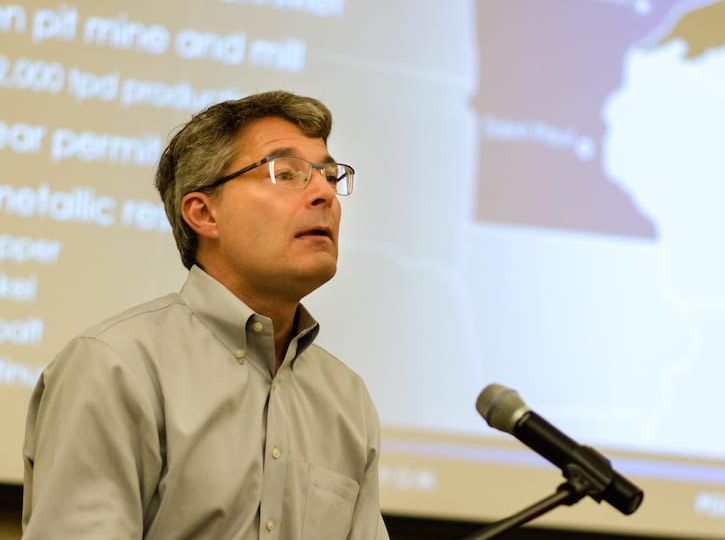
When the Political Awareness Committee PAC announced a dinner with Brad Moore ’83 to discuss a proposed mining project in northern Minnesota, some students expected heated debate about the controversial topic. Instead, the Feb. 24 dinner discussion allowed for civil debate of a complicated issue.
Tim Bergeland ’18, the freshman PAC representative and coordinator of the PolyMet dinner discussion, said, “This was an issue that is important to a lot of Minnesotans, we wanted to address that in some way.”
The event started with a 45-minute presentation by Moore, Executive Vice President of Environmental and Government Affairs for PolyMet, about the effects of the proposed mine.
PolyMet mining is close to breaking ground on a copper and nickel mine in the Lake Superior watershed near the community of Hoyt Lakes. PolyMet has cleared the public commenting period and only has one more environmental review before it starts the permitting process.
At the beginning of the dinner, Moore said, “No mining situation is perfect, but this project has come a long way.” Throughout the dinner, Moore argued that the proposed mining project has undergone numerous modifications and improvements.
After his initial disclaimer, the talk turned to the economic and environmental benefits of the mine. An important feature of the PolyMet mine project is the reuse of the same facility and tailings basin of a mine that operated in the 1970s.
The original mine had fewer environmental regulations. In fact, some of the work of the PolyMet mine will be to mitigate the damaging effects of the old mine.
“For every acre of wetland we use, we are restoring an acre and a half,” Moore said.
The PolyMet reworking of the old mine will bring an estimated 400 long-term jobs back into the struggling community.
“St. Louis County will get an additional $500 million in taxes and increased spending,” Moore said.
There is only one other nickel mine in the United States. The mine near Lake Superior could make Minnesota a central player in these key resources.
Claire Bransky ’17 challenged Moore on Polymet’s job statistics.
“As someone from northern Minnesota, I can appreciate the need for economic revival,” Bransky said. “However, according to some estimates, 55 percent of jobs will be non-local and 20 percent will be commuters from centers like Duluth. Do you think that PolyMet has done everything it can to employ local people and keep the money local?”
Moore disputed these statistics.
“Those numbers are a bit exaggerated,” he said. “We have done research that shows about 75 to 80 percent of jobs will be local, and those jobs will act as an enticement for people to move to this area.”
When asked about the public opinion toward the mine, Moore said, “There is more opposition in the metro area than in Northern Minnesota.” He went on to say, “This is a community that is really struggling. They are struggling to keep enough kids in the schools – there is no year-round economic stability in this region. They can’t even keep a Pizza Hut open in the winter.”
The question and answer period of the dinner ended nearly 15 minutes late.
“I thought that it went well, everyone was respectful and the dialogue was really constructive,” Bergeland said.
barke1@stolaf.edu
Photo Credit: ANDREW WILDER/MANITOU MESSENGER

